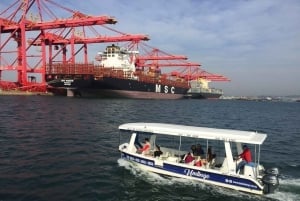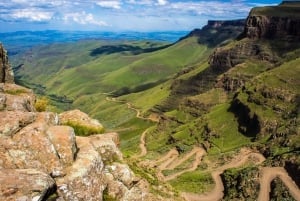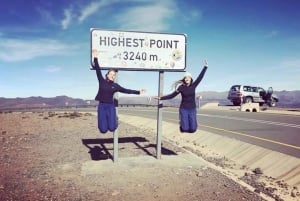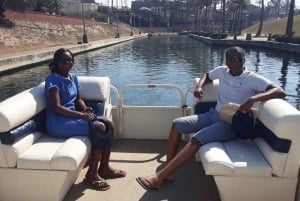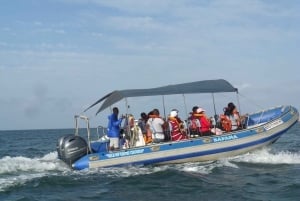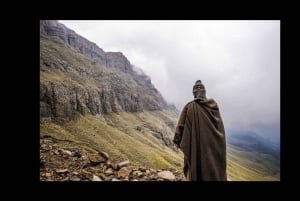Durban Attractions
Sardine Festival
South Africa has much to offer the overseas visitor or local holidaymaker throughout the year. But during the winter months one might expect this not be the case. However, for the east coast of South Africa, and especially the province of KwaZulu Natal, it is simply the best time to visit. Brilliant sunny days that seem to go on forever, no rain and wonderfully mild daytime temperatures are perfect holiday conditions. So you have a compelling reason to visit. But wait, there is another reason as well.
Sometime in the month of June, and somewhere in the cool, deep ocean off Cape point in the Western Cape Province of South Africa – for reasons we are not entirely sure of – a teeming shoal of brilliant silver sardines begins to assemble. The shoal grows in size until it numbers in the millions – and begins what has famously become known as "the greatest shoal on earth". This vast shoal (estimated at ten million annually) begins to move up the east coast of South Africa, pursued by a huge number of predators – on average 100,000 sea birds (gannets), 1000 sharks and 23,000 dolphins, as well as 500 whales. The greatest shoal on earth becomes the greatest feeding frenzy, as the predators scramble to take their pick.
This is the beginning of KwaZulu Natal’s sardine run, an annual event that has become a "must do" for holidaymakers, divers and fishermen – in fact anybody who is in striking distance of the coast. It is a spectacle that is not easily forgotten. Huge moving silvery masses of sardines (sometimes more than 7 kms long and 30m deep) can be seen, and some come ashore in pockets – caught by incoming tides. And that is when the fun starts. A field day for fishermen or anybody willing or able to scoop up sardines in any available receptacle, in what has locally become known as sardine fever!
But there is so much more than the sardine bounty from the sea to make these winter months full of fun and excitement. In celebration of the sardine run, Tourism KwaZulu Natal, in partnership with the South Coast Tourism and the KwaZulu Natal Sharks Board have, since 2006, organized the Sardine Festival, which is a comprehensive programme of entertainment involving marine, beach, cultural and music activities. So much to do and something not to be missed.
Events and schedules for the Sardine Festival vary from year to year, but in 2009 highlights included the popular Ugu Jazz Festival, the Margate Air show, the Mallards Mercury Ski Boat festival and the Mariners Portuguese Food and Wine Festival in Port Edward. The south coast of KwaZulu Natal has been called winters best known secret in the past. And now you know why!
More information on the Sardine Festival
Dusi Canoe Marathon
The port city of Durban is situated about 90 km east of Pietermaritzburg, the provincial capital of KwaZulu Natal. The history of these two cities – the largest in the province – is inextricably linked, and the road trip between them is nowadays completed with ease in less than an hour. But for some, the journey between the two cities is a teat of utter endurance, and a journey that never gets any easier. But it is a challenge, and when there’s a challenge there’s a will and a way. That is the stuff of the Dusi Canoe Marathon.
The annual three day Hansa Powerade Dusi Canoe Marathon is one of the largest of its kind in the world. Since it was first completed in 1951, the race has evolved into an international sporting event with widespread media coverage. In South Africa it has become the first major sporting event of the year.
The Dusi Canoe Marathon begins each January in Pietermaritzburg, and attracts about 2000 participants – men and women of all ages – as well as 2000 to 3000 seconders or supporters, as well as the attendant media and excited crowds thronging the route. After the beginning of the race on the Msunduzi River (from which the name Dusi is derived) in Pietermaritzburg, the race offers different levels of excitement and challenges to the human spirit, encountered in no other sporting event of its kind.
The special difficulties of the race are the varied challenges that lie ahead – long period of portaging over very difficult terrain and other periods maneuvering through dangerous, surging rapids. Tremendous heat and humidity try even the toughest spirit, and it’s only the training and preparation that gets you through. After all it’s one of the toughest canoe races around.
The 120 km route is undertaken with two overnight stops. The final day is the one that evokes the main interest. Crowds begin to wait at the end-point at Durban’s Blue Lagoon well before the expected finish time. The wait seems endless, until eventually, somehow out of nowhere, the leading canoe comes into sight and the final effort to reach the finish is greeted by clapping and cheers. It is not a day to miss if you are in Durban. Ian Player, who was the first to complete the race in 1951, once said that nobody who has completed the race will ever be the same again. The men and women who have completed the famous Dusi Canoe Marathon would almost certainly agree.
Race information:
| Date: | 16th to 18th of February |
| Start: | 16th February 2012 in Pietermaritzburg |
| Finish: | 18th February 2012 in Durban |
More information on the Dusi Canoe Marathon
Comrades Marathon
The 90 km between Durban and Pietermaritzburg is the setting for one of the worlds most grueling and thrilling sporting event. Run on an alternating up or down run basis between the two cities, the Comrades Marathon is a South African sporting institution. Undertaken on a public holiday in May or June of each year, it is a legendary ultra-marathon, unlike any other in the world. The race was the idea of a First World War veteran who wanted a living memorial to South African soldiers killed in the war. The race was to a unique, excruciating test of the physical endurance of all its entrants. Ever since the first race in 1921, the Comrades Marathon has evoked the full range of human emotions – joy, anguish, despair, thrills, fulfillment, desperation and – more than anything else endurance and the will to succeed. It is the ultimate test of endurance on the South African sporting calendar.
The Comrades Marathon started from humble beginnings in 1921 with only 34 runners. Today there are almost 13,000 entrants and about three-quarters manage to finish in the allotted 12 hours. The race begins at 5h30 am on a cold, dark winter’s morning – to the legendary sound of a cock crow. For the next twelve hours the drama of the ever-changing fortunes of the runners holds the interest of millions of South Africans, during an uninterrupted national TV broadcast. Those fortunate enough to live along the route make their way to the roadside to watch and encourage runners as they go by. Some with ease, others limping, some in obvious discomfort, still others just managing to walk. In many ways the event as just as important to the runners as it is to the spectators, many of whom secure positions along the route the day before, and enjoy their time to the full – a day filled with bonhomie and relaxation.
It is towards the end of the race, many hours after the winners have completed the course, that the true drama of the Comrades Marathon peaks. After an unbearingly long day, only minutes remain to the firing of the shot at the finishing line that ends it all. Almost like an executioner, the linesman stands with his back to the last of the runners struggling towards the finishing line – gun in air. Pandemonium breaks loose in the stadium. Thousands of spectators almost implore the gun not to be fired. A frantic flow of runners struggles towards the finish-line, some running with joyously upheld arms, some walking, some being carried, some literally crawling on their hands and knees. Who makes it, who doesn’t? That is the thrill of the Comrades Marathon. A celebration of mankind’s spirit over adversity.
Race information:
| Date: | Sunday 3 June 2012 |
| Start: | 05h30 at the City Hall, Pietermaritzburg |
| Finish: | 17h30 at the Sahara Stadium, Kingsmead, Durban |
More information on the Comrades Marathon
Umhlanga Rocks Beachfront
A kind of Beverly Hills by the sea, Umhlanga Rocks is one of South Africa’s top holiday destinations. Upmarket, sophisticated and with many luxury beachfront complexes, hotels and some high rise buildings, and yet with a certain genteel charm found nowhere else in the Durban metropole, Umhlanga Rocks is a beach resort with a difference. The beachfront itself is home to several of South Africa’s most fabled hotels and resorts, with a fine tradition in catering to the needs of discerning holiday visitors. This tradition traces back to 1869 when Umhlanga’s first beach cottage, the Oyster Lodge, was built. In the spirit of Umhlanga’s renowned hospitality, tea and scones were served to passers-by and its reflective roof also served as a beacon for passing ships to navigate safely around Umhlanga’s rocky headland. In 1954 Umhlanga's distinctive red and white lighthouse was built, and thereafter the Umhlanga Rocks Hotel (now demolished) and two of South Africa’s iconic five star hotels - The Oyster Box, and the Beverly Hills hotel itself. These fabulous hotels are a constant reminder that Umhlanga Rocks is a world class holiday destination.
The beachfront at Umhlanga Rocks is undoubtedly its best asset. A leisurely, get-away-from-it-all enclave, it offers a huge variety of leisure activities to holidaymakers of all ages. Defined by its magnificent beachfront promenade overlooking the sea, Umhlanga Rock’s golden beaches are enticing and just the place to spend a day in the sun. The shore-hugging promenade is a superb people-friendly pathway rambling for about 3 km in each direction. For serious walkers and joggers there are distance markers in place, but your leisurely stroll is catered for with strategically placed viewing benches and rest stops. Perfect for viewing the breakers of the warm Indian Ocean or just for people-watching. At its northern extent is the beautiful Umhlanga Lagoon Nature Reserve trail, offering a one and a half hour ramble through unspoiled coastal forest. Ideal for bird watching and – when you need it – a break from the fun and sun on the safe, expansive, sandy beaches.
Umhlanga’s beautiful beaches are well known for their safety (all protected by shark nets), high levels of cleanliness, toilet and shower facilities, parking access and professional lifeguard services. Perhaps you think you could not expect anything more – but you can! Ocean enthusiasts and outdoor adventurers are in their element on the beachfront – surfing, deep-sea fishing, whale and dolphin viewing, scuba diving, kite boarding and microlight flips are just some of the many activities available on this magnificent stretch of coastline.
Photo by Ivan Fourie @ flickr.com
The Golden Mile
Synonymous with surf, sea, sun and pleasure, the Golden Mile is Durban’s most famous tourist attraction. This is Durban’s main beachfront, and runs between uShaka Marine World in the south to the Suncoast Casino and Entertainment World in the north. The long stretch of golden sands is seemingly designed with your pleasure in mind, and is easily accessible from the beachfront promenade along its entire length. These golden sands have been the backdrop for countless seaside holidays over the years. Sometimes referred to as South Africa’s Miami Beach, the Golden Mile certainly does have a touch of Florida about it - there is a cosmopolitan vibe and a holiday atmosphere that never ends. It’s no surprise then that Durban with its Golden Mile have just been listed as one of the top ten family beach holiday cities in the world by travel publishing heavyweight "Lonely Planet".
Durban’s subtropical climate is warm and balmy throughout the year, and there is an almost uninterrupted swimming season in the warm waters of the Indian Ocean. The wide stretch of golden sands provide endless opportunities for sun-worshippers and swimmers to enjoy this amazing holiday destination, and with your safety in mind most of the beaches are protected by shark nets and life guards. The Golden Mile is in effect a huge pleasure resort, and boasts dozens of swimming and splash pools, fountains and waterslides and curio markets. Well catered for by world class restaurants, nightclubs, hotels and apartment complexes along the beachfront, there is also an upbeat nightlife. In fact the sun never sets on your pleasure.
The Golden Mile is also renowned internationally as a surfer's paradise, and the South Beach end is well known as a safe beach for newcomers to the surfing fraternity. Several important national and international surfing competitions and festivals take place at the beachfront, and are part of the holiday entertainment. But surfers be prepared to share the waves! Numerous other water-sports are also enjoyed - including body boarding, sailing, wind surfing, canoeing and scuba diving.
After your spell in the sea and sun, why not take a walk along that long beachfront promenade, and watch the waves and breakers and the passing parade. It has so much to offer and is guaranteed to keep you entertained. Take in Mini Town - a miniature replica of Durban complete with a working miniature railway and airport, enjoy the exotic wares of the traditional market vendors with a wide selection of Zulu art and crafts. And then, if you want a trip to remember, take a ride on one of Durban’s famous rickshaws. The iconic Zulu-pullers are well known for their flamboyant head-dresses adorned with beads and other decorations.
Come and experience the Golden Mile for yourself. Vibrant, alive, enticing and filled with fun, sun and pleasure. Durban’s holiday playground has a bit of something for everybody.
Photo by Marc Forrest @ flickr.com







